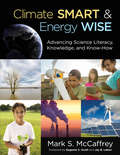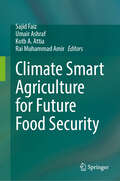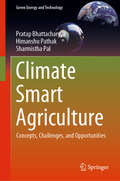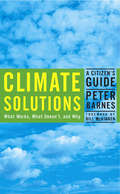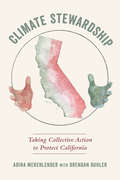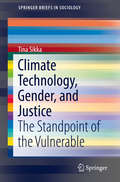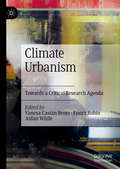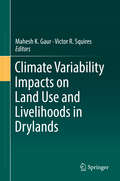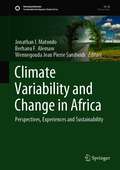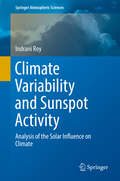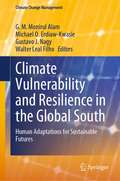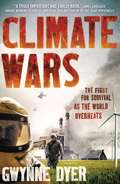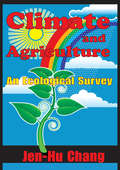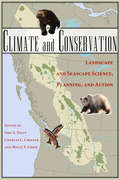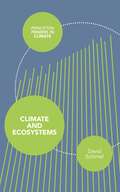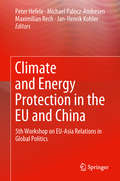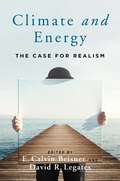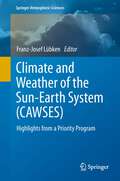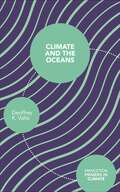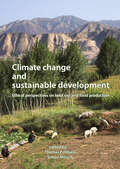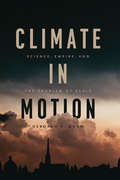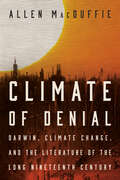- Table View
- List View
Climate Smart & Energy Wise: Advancing Science Literacy, Knowledge, and Know-How
by Mr Mark S. McCaffreyToday’s answers to our most urgent climate issues The twenty-first century ushered in a set of unmistakably urgent global challenges that are too important to be an afterthought in today’s classrooms. Climate Smart & Energy Wise offers a virtual blueprint to climate and energy education, packed with resources and strategies, including: A high-level overview of where climate and energy topics fit (or don't fit) into your current curriculum with connections to the NGSS Proven methods to teach climate change and related topics in a grade-appropriate way Sample learning activities and high-quality online resources
Climate Smart Agriculture for Future Food Security
by Sajid Faiz Umair Ashraf Kotb A. Attia Rai Muhammad AmirThis contributed volume covers recent advancements in the development of climate-resilient agriculturally important crops by focusing on climate change, crop cultivation, crop breeding, and the application of novel biotechnological approaches in line with attaining second Sustainable Development Goal of zero hunger. Climate-smart agriculture is a concept aimed at transforming and reorienting agricultural production systems to ensure food security in the ever-evolving situation of climate change. Widespread alterations in rainfall and temperature patterns have threatened agricultural production and elevated the vulnerability of human dependency on agriculture for food, feed, and fiber. Additionally, global food demand is estimated to increase to feed the estimated global population of 9.7 billion by the year 2050. Climate change, food, and nutritional insecurity pose the greatest challenges for the farming community, researchers, the private sector, civil society, and policymakers to develop more sustainable solutions ensuring food security, plant adaptability, and the mitigation of adverse effects on sustainable food production systems. This book will cover three pillars defined by the Food and Agriculture Organization of the United Nations for climate-smart agriculture: sustainable increase in agricultural production, adaptation, and plant resilience under climate change, and mitigation of environmental degradation through intensive agricultural practices. Furthermore, the book also highlights technological innovations taking place across different disciplines of agriculture to cater to both biotic and abiotic factors in agronomically important crops. This book serves as a useful resource documenting all recent developments made to achieve sustainable crop production. It is an interesting read for master&’s and doctoral-level students, academics, scientists, and researchers in the field of agronomy and agricultural biotechnology.
Climate Smart Agriculture: Concepts, Challenges, and Opportunities (Green Energy and Technology)
by Pratap Bhattacharyya Himanshu Pathak Sharmistha PalThe books deals with the critical issues of climate change and its impact on agriculture and proposes climate smart agriculture as the probable solution to this issue. It discusses the impact of climate change and greenhouse gases emission on agriculture. It covers the strategies and management options of climate smart agriculture by including crop, water, soil, and energy management with examples and case studies. The subject matter has been presented in a very lucid language, containing real-time case studies, questions and few solved problems in specific chapters. The text is further enriched with simple line diagram and figures, chart, flow charts and tables. The book is primarily intended for researchers and professionals in the research areas of environmental science, agriculture, soil science, etc.
Climate Solutions
by Peter BarnesIn 2006, NASA's top climate scientist warned that we have at most a decade to turn the tide on global warming. After that, James Hansen said, all bets are off. Temperature rises of 3 to 7 degrees Farenheit will "produce a different planet. " If Hansen is right-and most scientists think he is-then every year lost is a year closer to the precipice. In more positive terms, we have one last chance-but one chance only-to save the planet. This guide is about that last chance. It's a result of hundreds of how-do-we-do-this-right discussions over many years. Author and entrepreneur Peter Barnes want to share what he's learned in these discussions because the climate crisis must be solved now, and popular understanding is a pre-requisite to getting a solution that actually solves the problem. As a result of these numerous discussions, Barnes come to appreciate that climate policy isn't as simple as one would want it to be. But it's not rocket science, either. When details get complicated, the key is to remember what we, as a nation and a species, must very quickly do: install a workable and lasting system for limiting our use of the atmosphere.
Climate Solutions: A Citizen's Guide
by Peter BarnesIn 2006, NASA's top climate scientist warned that we have at most a decade to turn the tide on global warming. After that, James Hansen said, all bets are off. Temperature rises of 3 to 7 degrees Fahrenheit will "produce a different planet." If Hansen is right--and most scientists think he is--then every year lost is a year closer to the precipice. In more positive terms, we have one last chance-but one chance only-to save the planet. This guide is about that last chance. It's a result of hundreds of how-do-we-do-this-right discussions over many years. Author and entrepreneur Peter Barnes want to share what he's learned in these discussions because the climate crisis must be solved now, and popular understanding is a prerequisite to getting a solution that actually solves the problem. As a result of these numerous discussions, Barnes come to appreciate that climate policy isn't as simple as one would want it to be. But it's not rocket science, either. When details get complicated, the key is to remember what we, as a nation and a species, must very quickly do: install a workable and lasting system for limiting our use of the atmosphere.
Climate Stewardship: Taking Collective Action to Protect California
by Adina MerenlenderAs climate disruption intensifies the world over, Californians are finding solutions across a diversity of communities and landscapes. Though climate change is a global existential threat, we cannot wait for nation-states to solve the problem when there are actions we can take now to protect our own communities. In Climate Stewardship: Taking Collective Action to Protect California, readers are invited on a journey to discover that all life is interconnected and shaped by climate and to learn how communities can help tackle climate change. Climate Stewardship shares stories from everyday people and shows how their actions enhance the resilience of communities and ecosystems across ten distinct bioregions. Climate science that justifies these actions is woven throughout, making it easy to learn about Earth's complex systems. The authors interpret and communicate these stories in a way that is enjoyable, inspiring, and even amusing. California is uniquely positioned to develop and implement novel solutions to widespread climate challenges, owing to the state's remarkable biogeographic diversity and robust public science programs. Produced in collaboration with the UC California Naturalist Program, Climate Stewardship focuses on regenerative approaches to energy, agriculture, and land and water use across forested, agricultural, and urban landscapes. The authors' hopeful and encouraging tone aims to help readers develop a sense that they, too, can act now to make meaningful change in their communities.
Climate Technology, Gender, and Justice: The Standpoint Of The Vulnerable (Springerbriefs In Sociology Ser.)
by Tina SikkaThis book is the first to undertake a gendered analysis of geoengineering and alternative energy sources. Are either of these technologies sufficiently attendant to gender issues? Do they incorporate feminist values as articulated by the renowned social philosopher Helen Longino, such as empirical adequacy, novelty, heterogeneity, complexity and applicability to human needs? The overarching argument in this book contends that, while mitigation strategies like solar and wind energy go much further to meet feminist objectives and virtues, geoengineering is not consistent with the values of justice as articulated in Longino's feminist approach to science. This book provides a novel, feminist argument in support of pursuing alternative energy in the place of geoengineering. It provides an invaluable contribution for academics and students working in the areas of gender, science and climate change as well as policy makers interested in innovative ways of taking up climate change mitigation and gender.
Climate Time Series Analysis: Classical Statistical and Bootstrap Methods (Atmospheric and Oceanographic Sciences Library #51)
by Manfred MudelseeClimate is a paradigm of a complex system. Analysing climate data is an exciting challenge, which is increased by non-normal distributional shape, serial dependence, uneven spacing and timescale uncertainties. This book presents bootstrap resampling as a computing-intensive method able to meet the challenge. It shows the bootstrap to perform reliably in the most important statistical estimation techniques: regression, spectral analysis, extreme values and correlation. This book is written for climatologists and applied statisticians. It explains step by step the bootstrap algorithms (including novel adaptions) and methods for confidence interval construction. It tests the accuracy of the algorithms by means of Monte Carlo experiments. It analyses a large array of climate time series, giving a detailed account on the data and the associated climatological questions. This makes the book self-contained for graduate students and researchers.
Climate Travels: How Ecotourism Changes Mindsets and Motivates Action
by Michael M. Gunter Jr.Many accounts of climate change depict disasters striking faraway places: melting ice caps, fearsome hurricanes, all-consuming fires. How can seeing the consequences of human impacts up close help us grasp how global warming affects us and our neighbors? This book is a travelogue that spotlights what a changing climate looks like on the local level—for wherever local happens to be.Michael M. Gunter, Jr. takes readers around the United States to bear witness to the many faces of the climate crisis. He argues that conscientious travel broadens understanding of climate change and makes its dangers concrete and immediate. Vivid vignettes explore the consequences for people and communities: sea level rise in Virginia, floods sweeping inland in Tennessee, Maine lobsters migrating away from American territorial waters, and imperiled ecosystems in national parks, from Alaskan permafrost to the Florida Keys. But Gunter finds inspiring initiatives to mitigate and adapt to these threats, including wind turbines in a tiny Texas town, green building construction in Kansas, and walkable urbanism in Portland, Oregon. These projects are already making a difference—and they underscore the importance of local action.Drawing on interviews with government officials, industry leaders, and alternative energy activists, Climate Travels emphasizes direct personal experience and the centrality of environmental justice. Showing how travel can help bring the reality of climate change home, it offers readers a hopeful message about how to take action on the local level themselves.
Climate Urbanism: Towards a Critical Research Agenda
by Vanesa Castán Broto Enora Robin Aidan WhileThis book argues that the relationship between cities and climate change is entering a new and more urgent phase. Thirteen contributions from a range of leading scholars explore the need to rethink and reorient urban life in response to climatic change. Split into four parts it begins by asking ‘What is climate urbanism?’ and exploring key features from different locations and epistemological traditions. The second section examines the transformative potential of climate urbanism to challenge social and environmental injustices within and between cities. In the third part authors interrogate current knowledge paradigms underpinning climate and urban science and how they shape contemporary urban trajectories. The final section focuses on the future, envisaging climate urbanism as a new communal project, and focuses on the role of citizens and non-state actors in driving transformative action. Consolidating debates on climate urbanism, the book highlights the opportunities and tensions of urban environmental policy, providing a framework for researchers and practitioners to respond to the urban challenges of a radically climate-changed world.
Climate Variability Impacts on Land Use and Livelihoods in Drylands
by Victor R. Squires Mahesh K. GaurThis edited volume is devoted to the examination of the implications of the inevitable changes wrought by global change on the welfare and livelihoods of tens of millions of people who live in dryland regions. Global change is more than just climate change and the ramifications of changing trade patterns (geopolitical and economic aspects), the shift to the market economy, demographic factors (population growth, urbanization and re-settlement), receive attention here. Land use change specialists, policy makers and natural resource management agencies will find the book very useful.Chapters focus on examples that are drawn from a number of sources including previously unpublished studies on the impact of climate change, markets and economics on pastoralist and dryland farming households. The key focus is to provide readers with insights into the real world implications of change (including an analysis of the drivers of change) on these vulnerable groups within dryland societies. The role of humans as agents of these changes is canvassed. A regional analysis of the world's drylands is also performed including those in Australia, Argentina, India, North America, China, North Africa, Central Asia and Southern Africa.
Climate Variability and Change in Africa: Perspectives, Experiences and Sustainability (Sustainable Development Goals Series)
by Jonathan I. Matondo Berhanu F. Alemaw Wennegouda Jean Pierre SandwidiThis book presents a comprehensive overview of climate variability and change in Africa, and includes impact assessments and case studies from integration frameworks, with a particular focus on climate, agriculture and water resources. Richly illustrated, the book highlights case studies from western, eastern and southern African region, and explores related development policies. Climate change adaptation research, prediction, and reanalysis are also addressed
Climate Variability and Sunspot Activity: Analysis of the Solar Influence on Climate (Springer Atmospheric Sciences)
by Indrani RoyThis book promotes a better understanding of the role of the sun on natural climate variability. It is a comprehensive reference book that appeals to an academic audience at the graduate, post-graduate and PhD level and can be used for lectures in climatology, environmental studies and geography. This work is the collection of lecture notes as well as synthesized analyses of published papers on the described subjects. It comprises 18 chapters and is divided into three parts: Part I discusses general circulation, climate variability, stratosphere-troposphere coupling and various teleconnections. Part II mainly explores the area of different solar influences on climate. It also discusses various oceanic features and describes ocean-atmosphere coupling. But, without prior knowledge of other important influences on the earth’s climate, the understanding of the actual role of the sun remains incomplete. Hence, Part III covers burning issues such as greenhouse gas warming, volcanic influences, ozone depletion in the stratosphere, Arctic and Antarctic sea ice, etc. At the end of the book, there are few questions and exercises for students. This book is based on the lecture series that was delivered at the University of Oulu, Finland as part of M.Sc./ PhD module.
Climate Vulnerability and Resilience in the Global South: Human Adaptations for Sustainable Futures (Climate Change Management)
by Walter Leal Filho Gustavo J. Nagy G. M. Monirul Alam Michael O. Erdiaw-KwasieThis book provides hands-on conceptual, theoretical, and case study discussions on vulnerability and resilience in the global south. This book covers the core of adaptation strategies in developing countries context in an easy-to-follow theoretical and empirical examples. This book shares contemporary approaches on vulnerability, adaptation strategies, and resilience, which aim to assist its targeted audience (academics, policymakers, and practitioners) to understand and make informed decisions in a wide variety of real-world resilience situations.
Climate Wars: The Fight for Survival as the World Overheats
by Gwynne DyerWaves of climate refugees. Dozens of failed states. All-out war. From one of the world's great geopolitical analysts comes a terrifying glimpse of the strategic realities of the near future, when climate change drives the world's powers towards the cut-throat politics of survival. Prescient and unflinching, Climate Wars will be one of the most important books of the coming years. Read it and find out what we're heading for.Gwynne Dyer has worked as a freelance journalist, columnist, broadcaster, and is author of several books, including War: The Lethal Custom, Future: Tense, and The Mess They Made.
Climate and Agriculture: An Ecological Survey
by Jen-hu ChangThis summary of what is known about microclimatic environments and the effects of climate on plant growth presents a comprehensive statement on the complex relationship between climate and agriculture. The author covers the theory and data of modern physical geography, meteorology, and agronomy within the context of contemporary ecological analysis to produce a book invaluable not only to the student and research worker but also one that deals for the first time with the application of theory to real problems of energy budgets and water balance for the practical agronomist.
Climate and Conservation: Landscape and Seascape Science, Planning, and Action
by Charles C. Chester Molly S. Cross Jodi A. HiltyClimate and Conservation presents case studies from around the world of projects focused on climate change adaptation-regional-scale endeavors where scientists, managers, and practitioners are working to protect biodiversity by protecting landscapes and seascapes in response to threats posed by climate change. The book begins with an introductory section that frames the issues and takes a systematic look at planning for climate change adaptation. The nineteen chapters that follow examine particular case studies in every part of the world, including landscapes and seascapes from equatorial, temperate, montane, polar, and marine and freshwater regions. Climate and Conservation offers readers tangible, place-based examples of projects designed to protect large landscapes as a means of conserving biodiversity in the face of the looming threat of global climate change.
Climate and Ecosystems (Princeton Primers in Climate #7)
by David SchimelHow does life on our planet respond to--and shape--climate? This question has never been more urgent than it is today, when humans are faced with the daunting task of guiding adaptation to an inexorably changing climate. This concise, accessible, and authoritative book provides an unmatched introduction to the most reliable current knowledge about the complex relationship between living things and climate. Using an Earth System framework, David Schimel describes how organisms, communities of organisms, and the planetary biosphere itself react to and influence environmental change. While much about the biosphere and its interactions with the rest of the Earth System remains a mystery, this book explains what is known about how physical and chemical climate affect organisms, how those physical changes influence how organisms function as individuals and in communities of organisms, and ultimately how climate-triggered ecosystem changes feed back to the physical and chemical parts of the Earth System. An essential introduction, Climate and Ecosystems shows how Earth's living systems profoundly shape the physical world.
Climate and Energy Protection in the EU and China: 5th Workshop On Eu-asia Relations In Global Politics
by Michael Palocz-Andresen Peter Hefele Maximilian Rech Jan-Henrik KohlerThis edited volume gives an insight into climate and energy protection in China and the European Union (EU). By taking a closer look at the EU and China seperately, the book presents the current situation in terms of environmental policy and energy use/ consumption in EU as well as in China. The book broaches the collaboration of the EU and China regarding climate and energy protection. The target audience primarily comprises research experts in the field of climate research as well as public decision makers.
Climate and Energy: The Case for Realism
by E. Calvin Beisner and David R. LegatesThe attempted cures for climate change are generally worse than the disease—especially for the poor. In this groundbreaking volume, experts in all the fields related to climate change explain for laymen what we know about climate change and evaluate from a Christian perspective the proposed responses.Demands to transform the global energy infrastructure to depend heavily on wind, solar, and other renewables are harmful to people in America and the world–especially to the poor. Meanwhile, continued large-scale use of traditional energy sources like nuclear, hydro, and fossil fuels would reduce poverty while doing less harm to the environment.Climate and Energy: The Case For Realism combines outstanding climate science, physics, economics, environmental science, political science, ethics, and theology to present a well-reasoned understanding of human-induced climate change and how to respond to it.
Climate and Weather of the Sun-Earth System: Highlights from a Priority Program (Springer Atmospheric Sciences)
by Franz-Josef LübkenCAWSES (Climate and Weather of the Sun-Earth System) is the most important scientific program of SCOSTEP (Scientific Committee on Solar-Terrestrial Physics). CAWSES has triggered a scientific priority program within the German Research Foundation for a period of 6 years. Approximately 30 scientific institutes and 120 scientists were involved in Germany with strong links to international partners. The priority program focuses on solar influence on climate, atmospheric coupling processes, and space climatology. This book summarizes the most important results from this program covering some important research topics from the Sun to climate. Solar related processes are studied including the evolution of solar radiation with relevance to climate. Results regarding the influence of the Sun on the terrestrial atmosphere from the troposphere to the thermosphere are presented including stratospheric ozone, mesospheric ice clouds, geomagnetic effects, and their relevance to climate. Several chapters highlight the importance of coupling mechanisms within the atmosphere, covering transport mechanisms of photochemically active species, dynamical processes such as gravity waves, tides, and planetary waves, and feedback mechanisms between the thermal and dynamical structure of the atmosphere. Special attention is paid to climate signals in the middle and upper atmosphere and their significance relative to natural variability.
Climate and the Oceans (Princeton Primers in Climate #5)
by Geoffrey K. VallisThe oceans exert a vital moderating influence on the Earth's climate system. They provide inertia to the global climate, essentially acting as the pacemaker of climate variability and change, and they provide heat to high latitudes, keeping them habitable. Climate and the Oceans offers a short, self-contained introduction to the subject. This illustrated primer begins by briefly describing the world's climate system and ocean circulation and goes on to explain the important ways that the oceans influence climate. Topics covered include the oceans' effects on the seasons, heat transport between equator and pole, climate variability, and global warming. The book also features a glossary of terms, suggestions for further reading, and easy-to-follow mathematical treatments. Climate and the Oceans is the first place to turn to get the essential facts about this crucial aspect of the Earth's climate system. Ideal for students and nonspecialists alike, this primer offers the most concise and up-to-date overview of the subject available. The best primer on the oceans and climate Succinct and self-contained Accessible to students and nonspecialists Serves as a bridge to more advanced material
Climate change and sustainable development: Ethical perspectives on land use and food production
by Thomas Potthast Simon MeischClimate change is a major framing condition for sustainable development of agriculture and food. Global food production is a major contributor to global greenhouse gas emissions and at the same time it is among the sectors worst affected by climate change. This book brings together a multidisciplinary group of authors exploring the ethical dimensions of climate change and food. Conceptual clarifications provide a necessary basis for putting sustainable development into practice. Adaptation and mitigation demand altering both agricultural and consumption practices. Intensive vs. extensive production is reassessed with regard to animal welfare, efficiency and environmental implications. Property rights pay an ever-increasing role, as do shifting land-use practices, agro-energy, biotechnology, food policy to green consumerism. And, last but not least, tools are suggested for teaching agricultural and food ethics. Notwithstanding the plurality of ethical analyses and their outcome, it becomes apparent that governance of agri-food is faced by new needs and new approaches of bringing in the value dimension much more explicitly. This book is intended to serve as a stimulating collection that will contribute to debate and reflection on the sustainable future of agriculture and food production in the face of global change.
Climate in Motion: Science, Empire, and the Problem of Scale
by Deborah R. CoenToday, predicting the impact of human activities on the earth’s climate hinges on tracking interactions among phenomena of radically different dimensions, from the molecular to the planetary. Climate in Motion shows that this multiscalar, multicausal framework emerged well before computers and satellites. Extending the history of modern climate science back into the nineteenth century, Deborah R. Coen uncovers its roots in the politics of empire-building in central and eastern Europe. She argues that essential elements of the modern understanding of climate arose as a means of thinking across scales in a state—the multinational Habsburg Monarchy, a patchwork of medieval kingdoms and modern laws—where such thinking was a political imperative. Led by Julius Hann in Vienna, Habsburg scientists were the first to investigate precisely how local winds and storms might be related to the general circulation of the earth’s atmosphere as a whole. Linking Habsburg climatology to the political and artistic experiments of late imperial Austria, Coen grounds the seemingly esoteric science of the atmosphere in the everyday experiences of an earlier era of globalization. Climate in Motion presents the history of modern climate science as a history of “scaling”—that is, the embodied work of moving between different frameworks for measuring the world. In this way, it offers a critical historical perspective on the concepts of scale that structure thinking about the climate crisis today and the range of possibilities for responding to it.
Climate of Denial: Darwin, Climate Change, and the Literature of the Long Nineteenth Century
by Allen MacDuffieMany people today experience the climate crisis with a divided state of mind: aware of the extreme effects, but living everyday life as if the crisis is not actually happening. This book argues that this structure of feeling has roots that can be traced back to the nineteenth century, when Western culture encountered the profound shock of Charles Darwin's theory of evolution. Darwin's theory made it increasingly difficult for secular humanists to flatly deny that humans are animals, fully enmeshed in natural systems and processes. But like those of us confronting climate change today, many writers and scientists struggled to integrate its depersonalizing vision into their understanding of the place of humans in the natural order. The result was that the radical environmental implications of The Origin of Species were evaded as soon as they were articulated, abetted by a culture of denial structured by the illusions of capital and empire. In light of the climate emergency, Climate of Denial recontextualizes nineteenth-century texts to offer rich insight into the defensive strategies used—then and now—to avoid confronting the unsettling realities of our situation on this planet.
